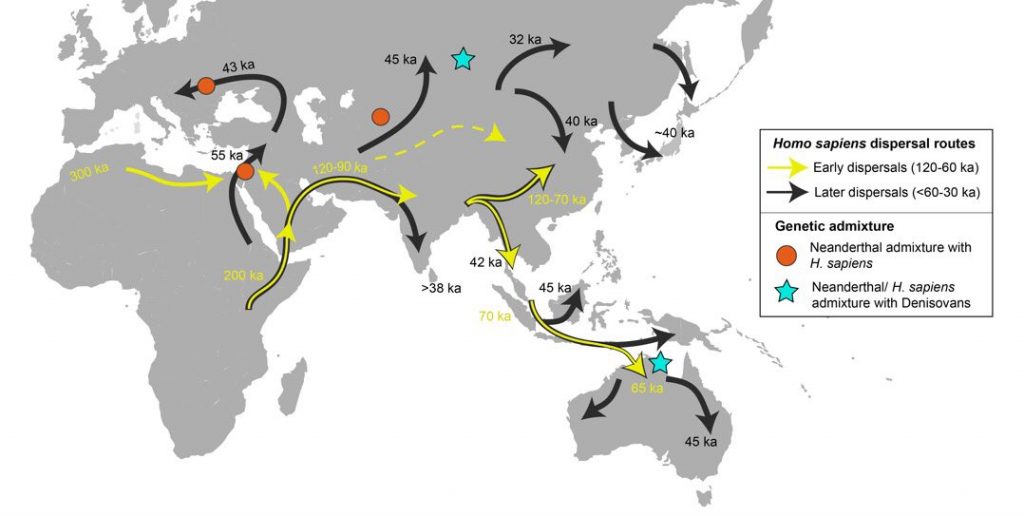Review article On the origin of modern humans: Asian perspectives, by Christopher J. Bae, Katerina Douka, and Michael D. Petraglia, Science (2017)
Abstract:
BACKGROUND
The earliest fossils of Homo sapiens are located in Africa and dated to the late Middle Pleistocene. At some point later, modern humans dispersed into Asia and reached the far-away locales of Europe, Australia, and eventually the Americas. Given that Neandertals, Denisovans, mid-Pleistocene Homo, and H. floresiensis were present in Asia before the appearance of modern humans, the timing and nature of the spread of modern humans across Eurasia continue to be subjects of intense debate. For instance, did modern humans replace the indigenous populations when moving into new regions? Alternatively, did population contact and interbreeding occur regularly? In terms of behavior, did technological innovations and symbolism facilitate dispersals of modern humans? For example, it is often assumed that only modern humans were capable of using watercraft and navigating to distant locations such as Australia and the Japanese archipelago—destinations that would not have been visible to the naked eye from the departure points, even during glacial stages when sea levels would have been much lower. Moreover, what role did major climatic fluctuations and environmental events (e.g., the Toba volcanic super-eruption) play in the dispersal of modern humans across Asia? Did extirpations of groups occur regularly, and did extinctions of populations take place? Questions such as these are paramount in understanding hominin evolution and Late Pleistocene Asian paleoanthropology.
ADVANCES
An increasing number of multidisciplinary field and laboratory projects focused on archaeological sites and fossil localities from different areas of Asia are producing important findings, allowing researchers to address key evolutionary questions that have long perplexed the field. For instance, technological advances have increased our ability to successfully collect ancient DNA from hominin fossils, providing proof that interbreeding occurred on a somewhat regular basis. New finds of H. sapiens fossils, with increasingly secure dating associations, are emerging in different areas of Asia, some seemingly from the first half of the Late Pleistocene. Cultural variability discerned from archaeological studies indicates that modern human behaviors did not simply spread across Asia in a time-transgressive pattern. This regional variation, which is particularly distinct in Southeast Asia, could be related at least in part to environmental and ecological variation (e.g., Palearctic versus Oriental biogeographic zones).
OUTLOOK
Recent findings from archaeology, hominin paleontology, geochronology, and genetics indicate that the strict “out of Africa” model, which posits that there was only a single dispersal into Eurasia at ~60,000 years ago, is in need of revision. In particular, a multiple-dispersal model, perhaps beginning at the advent of the Late Pleistocene, needs to be examined more closely. An increasingly robust record from Late Pleistocene Asian paleoanthropology is helping to build and establish new views about the origin and dispersal of modern humans.

Read more about the article in Materials provided by the Max Planck Institute for the Science of Human History.
Related:
- Review article about Ancient Genomics, by Pontus Skoglund and Iain Mathieson
- Indo-European demic diffusion model, 3rd Ed. – Revised October 2017
- Expansion of peoples associated with spread of haplogroups: Mongols and C3*-F3918, Arabs and E-M183 (M81)
- Human ancestry solves language questions? New admixture citebait
- Potential Afroasiatic Urheimat near Lake Megachad